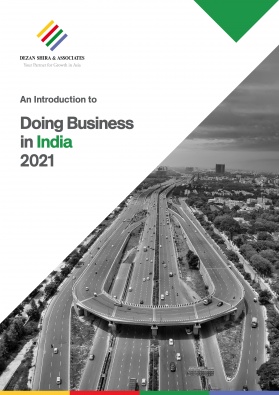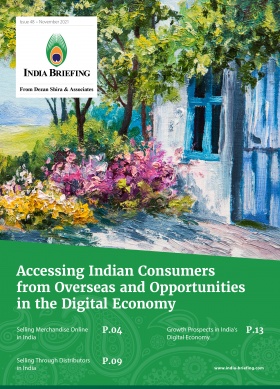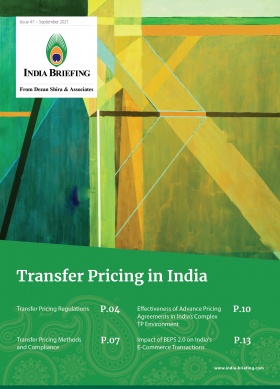What are Production-Linked Incentive Schemes and How Will They Improve India’s Manufacturing Capacity?
Production linked incentive (PLI) schemes were first introduced in India in March 2020, targeting three industries – mobile manufacturing and electric components, pharmaceutical (critical key starting materials/active pharmaceutical ingredients), and medical device manufacturing. The PLI concept has since expanded with schemes rolled out for multiple sectors to boost India’s manufacturing capabilities and encourage export-oriented production. The PLI schemes aim to develop capacities in the local supply chain, introduce new downstream operations, and incentivize investments into high-tech production.
As of November 2021, the PLI schemes covered 13 sectors with a total budgeted outlay of INR 1970 billion (US$26.48 billion). Each PLI scheme is applicable for a four to six-year duration period, depending on the sector. The table below lists the sectors that will benefit from the PLI scheme. They include sunrise sectors, labor-intensive sectors, and those industries where India wants to develop links to the global value chain.
For information on the schemes intended to boost semiconductor manufacturing, design, and R&D, as announced in December 2021, see our article – What is the Program for Development of Semiconductors and Display Manufacturing Ecosystem in India?
Through their implementation, it is hoped that economies of scale are created so that domestic manufacturing becomes competitive in India. The resultant benefits include job creation, export capabilities, and lessening the import dependency – particularly in critical sectors and high-tech goods.
It is envisaged that India’s total industrial production will increase by over US$520 billion during the period covering PLI policy implementation. Additionally, the government is also working on reducing compliance burden, improving the ease of doing business, creating multi-modal infrastructure to reduce logistics costs, and constructing district-level export hubs (see PDF from the Ministry of Commerce).
A statement on details received from concerned Ministries/Departments regarding investment made by various sectors after April 1, 2021, to avail the PLI scheme is placed in the table below.
How do the production linked incentive schemes work?
The PLI framework enables India to take definitive steps, in the near term, to expand the manufacturing potential of the economy. The pillars of the policy are:
- Creation of large-scale manufacturing capacity: Since the incentives are directly proportional to production capacity/ incremental turnover, it is expected that investors will be compelled to create large-scale manufacturing facilities. Furthermore, it is also expected to bring improvements in industrial infrastructure, benefiting the overall supply chain ecosystem.
- Import substitution and increase in exports: PLI schemes intend to plug the gap between the highly skewed Indian import- export basket, which is mainly characterized by heavy imports of raw materials and finished goods. The PLI schemes are intended to enable domestic manufacture of goods, thereby causing a reduction in reliance on imports in the short term and expanding quantum of exports from India over long term.
- Employment generation: As large-scale manufacturing requires large labor force, it is expected that the PLI schemes will utilize India’s abundant human capital and enable upskilling and technical education.
Implementation of the schemes
The PLI schemes provide eligible manufacturing companies incentives ranging from four to six percent on incremental sales over the base year of 2019-20 for a four to six-year period. It is like a subsidy being provided by direct payment – as budgeted – for domestically manufactured goods by the chosen beneficiaries.
The incentive amount offered varies across sectors and the savings generated from PLI of one sector can be appropriated towards other sectors in order to maximize returns. The PLI schemes are intended to incentivize large domestic and global players to participated in production and lead to more inclusive growth across the country.
Which sectors are covered under India’s PLI schemes?
There are 13 sector beneficiaries of the PLI schemes. They are as follows:
Automobiles and auto components
India’s federal government has approved the PLI scheme for automobile and auto components with a budgetary outlay of INR 259.38 billion (US$3.50 billion) to boost domestic manufacturing capacity, including the production of electric and hydrogen fuel cell vehicles. The main implementing agencies for the scheme is Ministry of Heavy Industries and Public Enterprises.
The government has released the full list of beneficiaries to this PLI scheme.
On March 15, 2022, 75 companies secured PLI approval under the Component Champion Incentive Scheme, including Maruti Suzuki, Hero MotoCorp, Tata Autocomp, Mitsubishi Electric, Toyota Kirloskar, Motherson Sumi, Bosch, and Lucas-TVS.
On February 11, 2022, 20 companies were approved as PLI beneficiaries under the “Champion OEM Incentive Scheme”. Altogether, the approved applicants (including existing automotive and auto component firms and new non-automotive industry investors) have proposed investments worth INR 450.16 billion (US$5.88 billion) under the Champion OEM Incentive Scheme and INR 298.34 billion (US$3.90 billion) under the Component Champion Incentive Scheme.
For a list of the approved applicant firms and investors, see Full List of Approvals Released: PLI Scheme for Automobile and Auto Components Industry.
Drones and drone components
Under the PLI Scheme for drones and drone components, the government has liberalized the minimum value addition criteria to 40 percent of net sales for drones and drone components. The budget of the scheme is INR 1.2 billion (US$16.13 million). The main implementing agencies for the scheme is Ministry of Civil Aviation. Applications are open till 23:59 hrs, March 31, 2022.
Advanced chemical cell (ACC) batteries
An outlay of INR 181 billion (US$2.43 billion) has been earmarked by the government towards the scheme, which is intended to establish local manufacturing capacity of 50 Giga Watt Hour (GWh) of ACC and five GWh of Niche ACC capacity. The main implementing agencies for the scheme are the Department of Heavy Industries and NITI Aayog. This scheme is also in sync with India’s objective of accelerating EV adoption over the coming decade, while also reducing the dependence on imports. The scheme is mainly targeted at large players.
Electronics and IT hardware
The implementing agency for this scheme is the Ministry of Electronics and Information Technology. It includes products like mobile phones, specified electronic components, laptops, tablets, all-in-one PCs, servers, etc.
-
- Electronics manufacturing: The budget outlay for this scheme is INR 400 billion (US$5.38 billion).
- IT hardware: The budget outlay for this scheme is INR 73.25 billion (US$984.68 million).
Food processing
Approved with an outlay of INR 109 billion (US$1.47 billion), the main implementing agency of this scheme is the Ministry of Food Processing. The ensuing benefits from the PLI scheme in this sector are expected to trickle down to farmers and help harness the massive employment generation potential in the sector.
The PLISFPI scheme is made up of the following components:
- Incentivize the manufacture of four major food product segments: ready-to-cook/ready-to-eat foods, marine products, processed fruits and vegetables, and mozzarella cheese. Innovative and organic products from small and medium-sized enterprises (SMEs), such as eggs, egg products, and poultry meat, are covered under this component.
- Support the branding and marketing of select Indian food products abroad to enable their entry into international food markets and increase their visibility. For example, the scheme is considering providing grants for applicant entities to establish in-store branding, shelf space renting, and marketing.
The Ministry of Food Processing closed PLI applications for the sector in June 2021. Applicants were examined on the following criteria:
- Category-I: Applicants are large entities who apply for Incentive based on Sales and Investment Criteria. Applicants under this category could undertake Branding & Marketing activities abroad also and apply for grant under the scheme with a common Application.
- Category-II: SMEs Applicants manufacturing innovative/ organic products who apply for PLI Incentive based on Sales.
- Category-III: Applicants applying solely for grant for undertaking Branding & Marketing activities abroad.
As of December 2021, approvals have been granted to one category of applicants.
Medical devices
The Indian Government has identified medical devices as a priority sector for the flagship ‘Make in India’ program and is committed to strengthening the manufacturing ecosystem. The PLI phase one of this scheme has been completed and phase two has been announced. The eligible medical device segments under this scheme include:
-
- Cancer care / radiotherapy: Brachytherapy systems, rotational cobalt machine, radiotherapy simulation systems, linear accelerator (linac), proton therapy system, etc.
- Radiology, imaging and nuclear imaging devices: CT Scan, MRI, ultrasonography, X-ray equipment, mammography, C-arm, Cath-Lab, positron emission tomography (PET) Systems, single-photon emission tomography (SPECT), cyclotrons, etc.
- Anesthetics, cardio-respiratory and renal care: Needles-anesthesia, syringes-anesthesia, anesthesia workstation, anesthesia unit gas scavengers, anesthesia kits, masks —anesthesia, anesthesia unit vaporizers, anesthesia unit ventilators, automated external defibrillators (AEDs), dialyzer, dialysis machine, peritoneal dialysis kits, etc.
- All implants: Cochlear implants, hip implants, knee implants, spinal and neuro-surgical implants, urogynecologic surgical mesh implants, hernia surgical mesh implants, cerebral spinal fluid (CSF) shunt systems, implanted pacemakers, insulin pump, implanted neuro-stimulated device like deep brain stimulator, intraocular lenses, heart valves, stents etc.
Specialty steel
Approved with an outlay of INR 63.22 billion (US$849.85 million), the main implementing agency of this scheme will be Ministry of Steel. This scheme will be implemented for a five-year period, from FY 2022-23, with the incentive to be released from FY 2023-24. The initial year may be delayed by up to two years in case of specific product categories. The release of the incentive will be from FY 2023-24 to 2027-28 (FY 2025-26 to FY 2029-30 in case of deferment by two years). The five categories of specialty steel that have been selected in the PLI scheme are coated/plated steel products, high strength/wear resistant steel, specialty rails, alloy steel products and steel wires, and electrical steel. Guidelines were released in November 2021 and the ministry has opened the window for applications.
Pharmaceuticals
The Indian pharmaceuticals market is supported by the following PLI schemes to boost domestic manufacturing capacity, including high-value products across the global supply chain. The implementing agency for these schemes is the Department of Pharmaceuticals.
-
- PLI scheme for Key Starting Materials (KSMs)/Drug Intermediates (DIs) and Active Pharmaceutical Ingredients (APIs) (PLI 1.0)
- PLI scheme for Pharmaceuticals d (PLI 2.0)
PLI Phase 1.0 for the pharmaceutical sector
In total 215 applications were received for 36 products spread across four target segments for the PLI Scheme for Bulk Drugs (PLI Phase 1.0). Out of these, 47 applications have been approved by the Government of India, with a total committed investment of INR 53.66 billion. The maximum incentive proposed for disbursement is INR 60 billion and expected employment generation will be worth INR 121.40 billion.
PLI Phase 2.0 for the pharmaceutical sector
The Department of Pharmaceuticals has announced the list of all 55 applicants selected to set up manufacturing facilities with a total quantum of INR 150 billion incentive.
Also read: Tax and Incentive Policies to Spur Investment in India’s Healthcare Sector
White goods
Total incentives applicable under the PLI scheme for white goods (Air Conditioners and LED Lights) will cost the government INR 62.38 billion (US$831.27 million). Second round for applications is open from March 10 to April 25, 2022.
The target segments under air conditioners are:
-
- Air conditioners (components – high value intermediates or low value intermediates or sub-assemblies or a combination thereof)
- High value intermediates (copper tubes, aluminum foil, and compressors)
- Low value intermediates (PCB assembly for controllers, BLDC motors, service valves, and cross flow fans for AC and other component
The target segments under LED include:
-
-
- LED lighting products (core components like LED chip packaging, registers, ICs, fuses, and large-scale investments in other components)
- Components of LED lighting products (like LED chips, LED drivers, LED engines, mechanicals, packaging, modules, wire wound inductors, and other components)
-
Solar photovoltaic (PV) modules
Total incentives for eligible investors in the production of solar modules will cost the government INR 45 billion (approx. US$599.99 million) under the PLI scheme.
Telecom and networking products
Approved with an outlay of INR 121.95 billion (US$1.64 billion), the main implementing agency of this scheme will be Department of Telecommunications. Recognizing the need for additional support to MSME units, it allows them additional incentives in the initial years. The list of target products include core transmission equipment, 4g/5g, next generation radio access network and wireless equipment, access & customer premises equipment (CPE), internet of things (IoT) access devices and other wireless equipment, enterprise equipment: switches and other products as maybe decided by empowered group of secretaries.
A total of 31 companies – 16 MSMEs and 15 non-MSMEs (eight domestic companies and seven global companies) have been found eligible by the Department of Telecommunications (DoT) under the PLI scheme. These 31 PLI beneficiaries are expected to invest US$447 million in the next four years and generate incremental employment for more than 40,000 people.
Investments made by successful applicants from April 1, 2021 onwards and up to FY 2024-25 are eligible for PLI benefits, subject to qualifying incremental annual thresholds. The PLI scheme seeks to boost research and development of new products on which 15 percent of the committed investment could be directed.
Textiles and apparels
Approved with an outlay of INR 106.83 billion (US$1.44 billion), the main implementing agency of this scheme will be Ministry of Textiles. This scheme intends to shift the textile production from natural fibers to man-made fibers (MMF) and technical textiles, aligning with global consumption patterns. The product segments under this sector will include MMF apparel and MMF fabrics as well as 10 segments / products of technical textiles.
Developing indigenous technical textiles manufacturing capacity is a key priority for the government as they have application in several sectors of the economy, including infrastructure, water, health and hygiene, defense, security, automobiles, aviation, etc. and- help secure sector efficiencies.
Incentive structure of the PLI for Textiles Scheme
The incentive structure has been so formulated that industry will be encouraged to invest in fresh capacities in these segments. There are two types of investment possible with different sets of incentive structure as stated below.
Phase 1: Any person (includes firm / company) willing to invest minimum INR 3 billion (US$39.81 million) in plant, machinery, equipment, and civil works (excluding land and administrative building cost) to produce products of notified lines (MMF fabrics, garment) and products of technical textiles, shall be eligible to apply for participation in the scheme. They will be entitled to incentives under the PLI Scheme once they achieve a turnover of at least INR 6 billion (US$79.6 million).
Structure of incentive: Participant companies achieving the minimum turnover requirements after a gestation period of two years and starting from FY 2024-25 are entitled to 15 percent incentive on attaining the required turnover in Phase 1 of the scheme. Incentives in subsequent years is contingent on turnover increasing by at least 25 percent each year up to FY 2028-29, with incentives falling by one percent each year to reach 11 percent in the final year of the scheme.
Phase 2: Any person (includes firm / company) willing to invest minimum INR 1 billion (US$13.27 million) shall be eligible to apply for participation in this part of the scheme. Those generating a turnover of at least INR 2 billion (US$26.53 million) will receive incentives. In addition, priority will be given for investment in Aspirational Districts, Tier 3, Tier 4 towns, and rural areas. This scheme will positively impact states like Gujarat, Uttar Pradesh, Maharashtra, Tamil Nadu, Punjab, Andhra Pradesh, Telangana, Odisha etc.
Structure of incentive: Producers with lower investment and turnover thresholds will be selected, and incentives will start at 11 percent for achieving the required turnover and fall by one percent each year to reach seven in FY 2028-29, with incentives after year-one being subject to a similar condition of 25 percent annual growth in turnover.
It is estimated that over the period of five years, the PLI Scheme for Textiles will lead to:
- Fresh investment of more than INR 190 billion (US$2.52 billion).
- Cumulative turnover of over INR 3 trillion (US$39.8 billion).
- Additional employment opportunities of more than 750,000 jobs in this sector and 100,000s more for supporting activities. The textiles industry traditionally employs more women and is expected to increase their participation in the formal economy.
This article was originally published on November 10, 2021. It was last updated March 15, 2022.
India Briefing is produced by Dezan Shira & Associates. The firm assists foreign investors throughout Asia from offices across the world, including in Delhi and Mumbai. Readers may write to india@dezshira.com for more support on doing business in in India.
We also maintain offices or have alliance partners assisting foreign investors in Indonesia, Singapore, Vietnam, Philippines, Malaysia, Thailand, Italy, Germany, and the United States, in addition to practices in Bangladesh and Russia.
- Previous Article Latest Amendments to LLP Act and LLP Rules to Ease Doing Business, Effective April 1
- Next Article Full List of Approvals Released: PLI Scheme for Automobile and Auto Components Industry




























